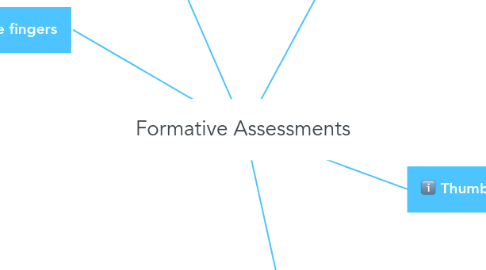
1. Stop and Jot
1.1. Powerful during any kind of analytical reading or intense discussion; gives students time to process.
1.2. If a student gives a particularly complicated argument, or if we reach an especially difficult part of the text, this can be really useful. It's especially helpful for evaluation.
1.3. Sample question: In what ways did Malcolm betray?
1.4. As long as we use an electronic resource, I could then evaluate whether or not students need additional discussion time, or if they're ready to move on.
2. Multiple-choice fingers
2.1. I use this tool nearly every day, when going over an ACT-style question at the beginning of class. If the answer is A, students put up one finger; two for B; etc.
2.1.1. Project specifications
2.1.2. End User requirements
2.1.3. Action points sign-off
2.2. When/Where/What if...
2.2.1. Effective during any kind of predictable multiple-choice question; is especially effective as part of a daily ritual. Gives clear indicator of student understanding and potential misunderstandings if there are shared errors.
2.2.2. Best used for projected or shared multiple choice questions; especially good for a quick gauge if there's a particular risk of a widespread misunderstanding.
2.2.3. This helps me figure out whether or not I need additional time to explain or reteach concepts. This is particularly effective when spiraling information.
3. Silent discussion
3.1. Using either a discussion forum site or google drive, students post responses to a controversial statement. They then can respond to other students by posting replies or by commenting.
3.2. Gives students a low-pressure way to quietly join a conversation; there's accountability because all student contributions are tracked and can be graded separately. This also gives an authentic moment when students can see other student writing, and use it to revise their own work.
3.3. If students are completely off-track with their responses, then I know I need to reteach and review the reading that the silent discussion was based on. This lets me know before students have committed to a long writing project that they're off-track.
3.4. Sample question: Do you agree or disagree with the following statement: Because he had a predisposition towards violence, Macbeth would have killed Duncan regardless of the witches.
4. Thumb Time
4.1. Students review plot points by throwing a beach ball around the class. Wherever their thumb lands, they need to respond to the question using facts from the book.
4.2. This is especially valuable when reviewing a book where arcane details end up being important, or when assessing basic comprehension of a shared text. It's important to make sure, before attempting analysis, that the basic plot points are in order.
4.3. If students are totally off-track, I know I need to go back to the reading itself to try to ascertain where the misunderstandings came from--if they're based on vocabulary issues, insufficient reading time, etc.
4.3.1. Sample questions: Identify the setting of the story; what does the main character learn? Etc.
5. Call on each other
5.1. Students have a discussion of a complex idea within a text without looking to me for reinforcement or correction; I start a timer and call on one student, who begins with argument, which is then built on by other students.
5.1.1. Materials
5.1.2. Personnel
5.1.3. Services
5.1.4. Duration
